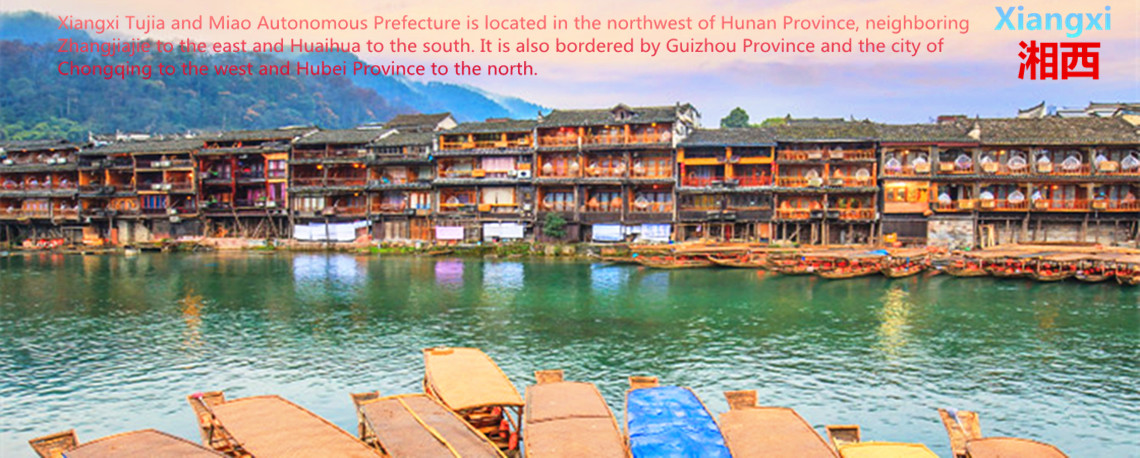
Fenghuang Ancient Town
Phoenix(Fenghuang) Ancient Town is situated on the western boundary of Hunan Province in an area of outstanding natural beauty where mountains, water and blue skies prevail. Upon arrival visitor will be impressed by its air of mystery, elegance and primitive simplicity. This is a world that is dominated by the colour green. The mountain slopes are covered with green foliage, the fields are green and even the Tuo Jiang River reflects the greenery. The bridges over the water and unique houses built on stilts display a harmony that is so often portrayed in traditional Chinese paintings. This is particularly true when mist pervades the scene in the early morning or after rain. It soon becomes apparent that the claim to being one of the two most beautiful towns in the whole of China is more than justified; the other town is Chang Ting in Fujian Province.
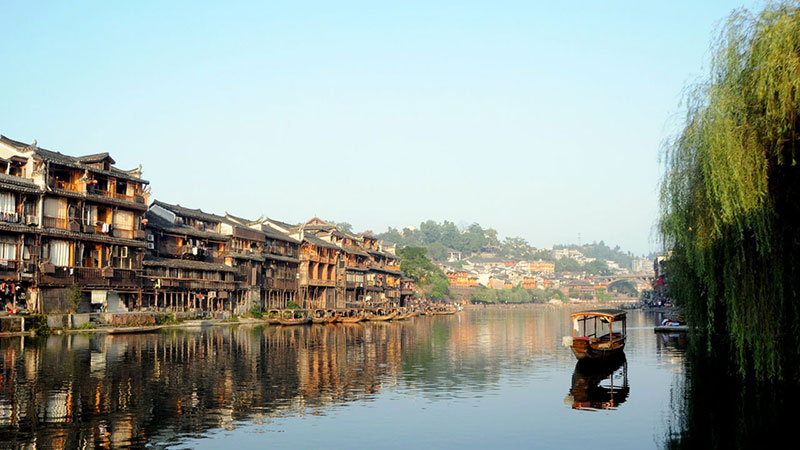
Phoenix Ancient Town is a wonderful example of what villages were like prior to the onset of modernization. Here dozens of alleys paved with flagstones run between the houses, each showing wear caused by the feet of generations of local people who have used them when going about their daily business. For the visitor, these alleys are the way to see the typical high gabled wooden houses built on stilts along the banks of the Tuo Jiang River at close quarters.
The Rainbow Bridge
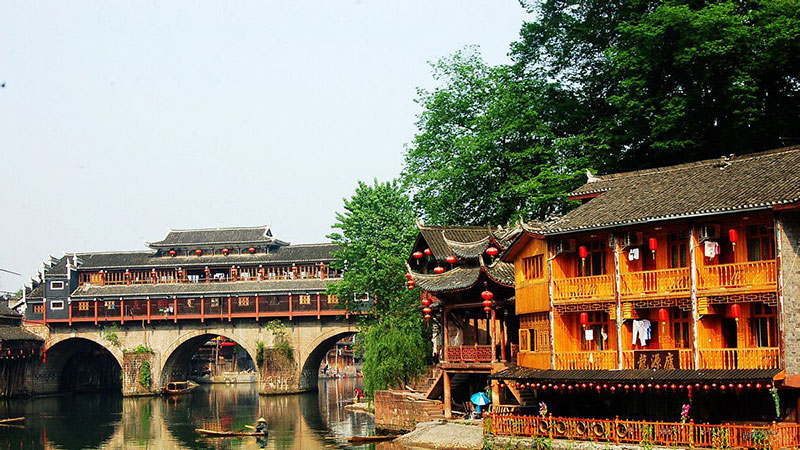
The Rainbow Bridge located at the center of town. A typical covered bridge, the Rainbow Bridge has a bright-vermeil (gold over sterling silver) body.
The Southern Great Wall
The Southern Great Wall is short for the Great Wall in southern China and is famous for being the only Great Wall in southern China. It is situated in Xiangxi Autonomous Prefecture in Hunan Province. Therefore, it is called Miaojiang Great Wall (Great Wall of Miao Territory). With a total length of 190 kilometers, the Miaojiang Great Wall is situated in Fenghuang County and starts north of Xique military camp (also known as Danwu military camp) of Guzhang County in western Hunan Province and south of Tingzi Pass of Tongren City in Guizhou Province, and is mostly constructed on precipitous ridges.
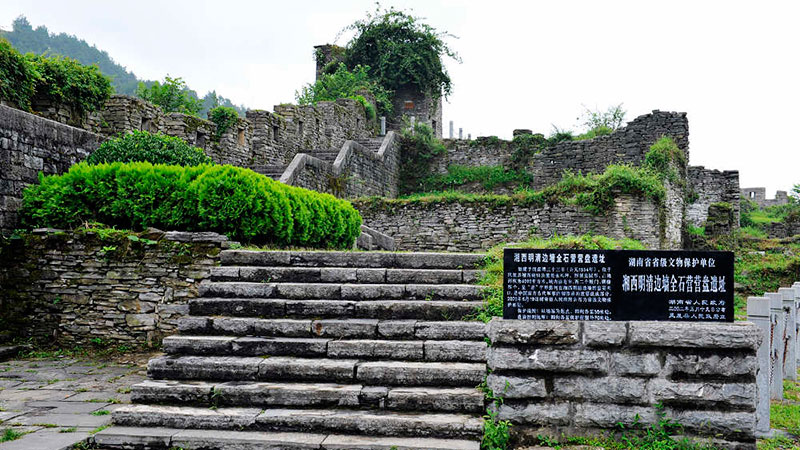
In order to consolidate their power, rulers in the Ming Dynasty and the Qing Dynasty suppressed the minorities in southern China, especially the Miao ethnic group. The Southern Great Wall was a result of their suppression. For the sake of continuous ruling and suppression, the rulers came up with the evil plan of building walls and stationing troops to separate the place. They separated the Miao territory in western Hunan Province into northern and southern parts and prescribed that "the Miao ethnic group must not come out from their territory, while the Han ethnic group must not step into Miao territory". Thus, economic trade and cultural exchanges between the Han and Miao people was cut off. It was a pass consisting of blockhouses, watchtowers, sentry posts, emplacements, gates, and houses outside or near the gates, which was used to isolate and conquer the Miao ethnic group.
History
With the government's appropriation of 40,000 taels of silver, the Southern Great Wall was primarily built during the Wanli period of the Ming Dynasty. During the late Ming Dynasty, the sidewalls were razed by the Miao ethnic group. Then the Qing Dynasty rebuilt new walls on the site of the old sidewalls.
Scale and Border Defense
There are over 1,300 blockhouses, watchtowers, sentry posts, emplacements and gates for stationing troops and defenses, including more than 800 of those in Fenghuang County. At that time, 4,000-5,000 soldiers used to be stationed along the section. It even increased to 7,000 at the height of the population. The walls have a height of 3 meters, a width of 1 meter at the top and 2 meters at the base. Therefore, local places were mostly named after paotai (an emplacement), shao (a sentry post), qia (a pass), bao (a fortress), diao (a blockhouse), guan (a pass) and lying(a military campus).
Generally, the Southern Great Wall is smaller than the one in northern China and the stone of it is between one sixth and one tenth of that of the Great Wall in northern China. This is because the military power of the Miao ethnic group wasn't very strong and it was unnecessary to build it as firmly as the Great Wall in northern China.
The Southern Great Wall not only had similar defensive functions as the Ming Dynasty's Great Wall in northern China, but it also had a similar military organization and soldier system, which meant that it was a complete part of the Chinese Great Wall.
Huangsiqiao Ancient Town Along the Wall
Huangsiqiao Ancient Town is located 28 kilometers west of Fenghuang County and lies in the strongholds of Hunan Province and Guizhou Province; it was built in 686 AD in the Ming Dynasty. Between the Ming Dynasty and the Qing Dynasty, it was the most significant military camp of the Southern Great Wall and was built into a stone town in 1700 AD. The wall of the town has a height of about 5 meters, a width of 3 meters and a circumference of 500 meters, with three gates in the town. There is a tower on every gate. All of these add tothe magnificence and uniqueness of Huangsiqiao Ancient Town.
Stilt house(Diaojiao house)
The stilt house (Diaojiao House), a kind of folk residence built on the stilts of different heights, is usually built beside the river or in steep mountain areas in Fenghuang Town. The stilt house is usually divided into two parts, the front part and the rear part. The front part is a storied building built on the ground and similar to the fence-style building, while the rear part is a bungalow. In front of the house is a corridor formed by wood balusters with a height of about 1 meter. Suspended windows were equipped in some houses for rest and enjoying cool. Sundries can be stored under the floor, and, by this, the space is utilized smartly. The space of the stilt house is arranged facilely in various shapes.
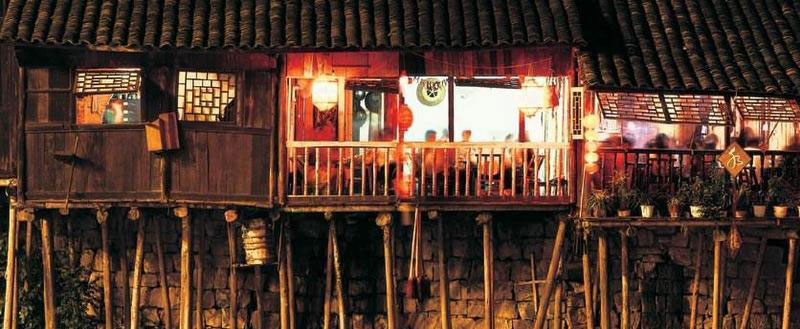
The shortage of construction land is relatively relieved, for the stilt house makes use of the hillside or river, which is originally not suitable for building houses. Furthermore, it has the advantages of aeration, moisture-proof, viper defense, and wild animal defense.



 Ask Questions ?
Ask Questions ?